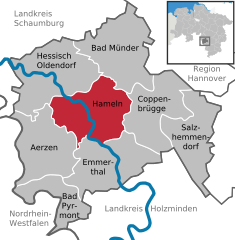Hamelin
| Hamelin Hameln | ||
|---|---|---|
 Panorama of Hamelin | ||
| ||
 Hamelin Location of Hamelin within Hamelin-Pyrmont district   | ||
| Coordinates: 52°6′N 9°22′E / 52.100°N 9.367°ECoordinates: 52°6′N 9°22′E / 52.100°N 9.367°E | ||
| Country | Germany | |
| State | Lower Saxony | |
| District | Hamelin-Pyrmont | |
| Government | ||
| • Lord Mayor | Claudio Griese (CDU) | |
| Area | ||
| • Total | 102.30 km2 (39.50 sq mi) | |
| Elevation | 68 m (223 ft) | |
| Population (2017-12-31)[1] | ||
| • Total | 57,228 | |
| • Density | 560/km2 (1,400/sq mi) | |
| Time zone | CET/CEST (UTC+1/+2) | |
| Postal codes | 31785–89, 3250 | |
| Dialling codes | 05151 | |
| Vehicle registration | HM | |
| Website | www.hameln.de | |
Hamelin (/ˈhæməlɪn/; German: Hameln) is a town on the river Weser in Lower Saxony, Germany. It is the capital of the district of Hamelin-Pyrmont and has a population of roughly 56,000. Hamelin is best known for the tale of the Pied Piper of Hamelin.
History
Hamelin started with a monastery, which was founded as early as 851 AD. A village grew in the neighbourhood and had become a town by the 12th century. The incident with the "Pied Piper" (see below) is said to have happened in 1284 and may be based on a true event, although somewhat different from the tale. In the 15th and 16th centuries Hamelin was a minor member of the Hanseatic League.
In June 1634, during the Thirty Years' War, Lothar Dietrich, Freiherr of Bönninghausen, a General with the Imperial Army, lost the Battle of Oldendorf to the Swedish General Kniphausen, after Hamelin had been besieged by the Swedish army.
The era of the town's greatest prosperity began in 1664, when Hamelin became a fortified border town of the Principality of Calenberg. In 1705, it became part of the newly created Electorate of Brunswick-Lüneburg, also called Hanover, when George Louis, Prince of Calenberg, later King George I of Great Britain, inherited the Principality of Lüneburg.
Hamelin was surrounded by four fortresses, which gave it the nickname "Gibraltar of the North". It was the most heavily fortified town in the Electorate of Hanover. The first fort (Fort George) was built between 1760 and 1763, the second (Fort Wilhelm) in 1774, a third in 1784, and the last (called Fort Luise) was built in 1806.
In 1808, Hamelin surrendered without fighting to Napoleon, after his victory at the Battle of Jena-Auerstedt. Napoleon's forces subsequently pulled down the town's historic walls, guard towers and the three fortresses at the other side of the river Weser. In 1843, the people of Hamelin built a sightseeing tower on the Klüt Hill, out of the ruins of Fort George. This tower is called the Klütturm and is a popular sight for tourists.
In 1867 Hamelin became part of the Kingdom of Prussia, which annexed Hanover in the aftermath of the Austro-Prussian War of 1866.
During the Second World War, Hamelin prison was used for the detention of Social Democrats, Communists, and other political prisoners. Around 200 died here; more died in April 1945, when the Nazis sent the prisoners on long marches, fearing the Allied advance. Just after the war, Hamelin prison was used by British Occupation Forces for the detention of Germans accused of war crimes. Following conviction, around 200 of them were hanged there, including Irma Grese, Josef Kramer, and over a dozen of the perpetrators of the Stalag Luft III murders. The prison has since been turned into a hotel.[2] Executed war criminals were interred in the prison yard until it became full; further burials took place at the Am Wehl Cemetery in Hameln. In March 1954, the German authorities began exhuming the 91 bodies from the prison yard; they were reburied in individual graves in consecrated ground in Am Wehl Cemetery.[2]
The coat of arms (German: Wappen) of Hamelin depicts the St. Boniface Minster, the oldest church in the city.[3]
Geography
Subdivisions

- Afferde
- Hastenbeck
- Halvestorf
- Haverbeck
- Hilligsfeld (including Groß and Klein Hilligsfeld)
- Sünteltal (including Holtensen, Welliehausen and Unsen)
- Klein Berkel
- Tündern (pop. around 2,700),[4]
- Wehrbergen
- Rohrsen
- Welliehausen
Demographics
| Year | Inhabitants |
|---|---|
| 1689 | 2,398 |
| 1825 | 5,326 |
| 1905 | 21,385 |
| 1939 | 32,000 |
| 1968 | 48,787 |
| 2005 | 58,872 |
2018 { 72, 655'
Attractions
Tale of the Pied Piper

The town is famous for the folk tale of the Pied Piper of Hamelin (German: Der Rattenfänger von Hameln), a medieval story that tells of a tragedy that befell the town in the 13th century. The version written by the Brothers Grimm made it popular throughout the world; it is also the subject of well-known poems by Goethe and Robert Browning. In the summer every Sunday, the tale is performed by actors in the town centre.
Government
Town twinning
Hamelin is twinned with:




Media
The Deister- und Weserzeitung, known as DeWeZet, publishes out of Hameln.
British army presence
Hamelin was home to several Royal Engineer units including 35 Engineer Regiment and 28 Amphibious Engineer Regiment until summer 2014, with many of the British families housed at Hastenbeck (Schlehenbusch) and Afferde. Also Royal Corps of Transport unit of 26 Bridging Regiment RCT, comprising 35 Sqn RCT and 40 Sqn RCT, until 1971.[5]
Notable people
- Glückel of Hameln (1646–1724), Jewish businesswoman and diarist
- Heinrich Bürger (1806–1858), German physicist, biologist and botanist
- Oswald Freisler (1895–1939), lawyer and brother of Roland Freisler
- Heinz Knoke (1923–1993), German officer of the Luftwaffe
- Karl Philipp Moritz (1756–1793), German author
- Peter the Wild Boy (found 1725), disabled boy
- Saint Vicelinus (1086–1154), born in the town[6]
- Electronic group Funker Vogt
- Johann Popken, founder of company that became Ulla Popken
- Max Richter (born 1966) neo-classical composer
- Ida Schreiter (1912–1948), concentration camp warden executed for war crimes
- Friedrich Sertürner, (1783–1841) first to isolate morphine from opium (1822–1841)
- Susan Stahnke (born 1967), German TV presenter
- Friedrich Wilhelm von Reden (1752–1815), German pioneer in mining
- Julius Wellhausen (1844–1918), Biblical scholar and orientalist
See also
Gallery
 The Leisthaus, Hamelin
The Leisthaus, Hamelin Jewish cemetery of Hamelin
Jewish cemetery of Hamelin The Golden Rat, on a footbridge over the River Weser in Hamelin
The Golden Rat, on a footbridge over the River Weser in Hamelin The Hochzeitshaus, the church's Glockenspiel plays the story of the Pied Piper of Hamelin
The Hochzeitshaus, the church's Glockenspiel plays the story of the Pied Piper of Hamelin
References
- ↑ Landesamt für Statistik Niedersachsen, Tabelle 12411: Fortschreibung des Bevölkerungsstandes, Stand 31. Dezember 2017
- 1 2 "Post World War II hangings under British jurisdiction at Hameln Prison in Germany".
- ↑ Start page at muenster-hameln.de
- ↑ Official site Archived 2007-04-21 at the Wayback Machine.
- ↑ "Archived copy". Archived from the original on 2012-12-30. Retrieved 2012-12-25.
- ↑ Vicelinus at the Catholic Encyclopedia
External links
| Wikimedia Commons has media related to Hameln. |
| Wikisource has the text of the 1911 Encyclopædia Britannica article Hameln. |
- Official website

- Hameln Notgeld (emergency banknotes) depicting the story of the Pied Piper of Hamelin http://webgerman.com/Notgeld/Directory/H/Hameln.htm